Categabriellah
On this page, you find all documents, package deals, and flashcards offered by seller categabriellah.
- 64
- 0
- 0
Community
- Followers
- Following
64 items
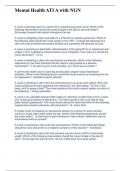
Mental Health ATI A with NGN
A nurse is planning care for a client who is experiencing acute mania. Which of the following interventions should the nurse include in the plan to promote sleep? - Encourage frequent rest periods throughout the day A nurse is delegating client care tasks to a LPN and an assistive personnel. Which of the following tasks should the nurse assign to the LPN? - Change the dressings of a client who has borderline personality disorder and superficial self-inflected wounds
- Exam (elaborations)
- • 7 pages •
A nurse is planning care for a client who is experiencing acute mania. Which of the following interventions should the nurse include in the plan to promote sleep? - Encourage frequent rest periods throughout the day A nurse is delegating client care tasks to a LPN and an assistive personnel. Which of the following tasks should the nurse assign to the LPN? - Change the dressings of a client who has borderline personality disorder and superficial self-inflected wounds
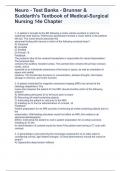
Neuro - Test Banks - Brunner & Suddarth's Textbook of Medical-Surgical Nursing 14e Chapter
1. A patient is brought to the ER following a motor vehicle accident in which he sustained head trauma. Preliminary assessment reveals a vision deficit in the patients left eye. The nurse should associate this abnormal finding with trauma to which of the following cerebral lobes? A) Temporal B) Occipital C) Parietal D) Frontal - B
- Exam (elaborations)
- • 95 pages •
1. A patient is brought to the ER following a motor vehicle accident in which he sustained head trauma. Preliminary assessment reveals a vision deficit in the patients left eye. The nurse should associate this abnormal finding with trauma to which of the following cerebral lobes? A) Temporal B) Occipital C) Parietal D) Frontal - B
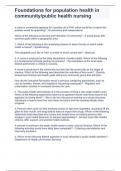
Foundations for population health in community/public health nursing
1. Which of the following is the underlying science or area of study on which public health is based? - Epidemiology The elizapbeth poor law of 1601 is similar to which current law? - Medicaid 2. A nurse is employed at the state department of public health. Which of the following is a fundamental principle guiding his practice? - The interaction of the local-state-federal partnership is critical to success.
- Exam (elaborations)
- • 8 pages •
1. Which of the following is the underlying science or area of study on which public health is based? - Epidemiology The elizapbeth poor law of 1601 is similar to which current law? - Medicaid 2. A nurse is employed at the state department of public health. Which of the following is a fundamental principle guiding his practice? - The interaction of the local-state-federal partnership is critical to success.
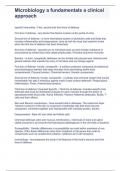
Microbiology a fundamentals a clinical approach
specific Immunities - First, second and third lines of defense First line of defense - any barrier that blocks invasion at the portal of entry Second line of defense - a more internalized system of protective cells and fluids that includes inflammation and phagocytosis. (acts at both the local and systemic levels when the first line of defense has been breeched
- Exam (elaborations)
- • 10 pages •
specific Immunities - First, second and third lines of defense First line of defense - any barrier that blocks invasion at the portal of entry Second line of defense - a more internalized system of protective cells and fluids that includes inflammation and phagocytosis. (acts at both the local and systemic levels when the first line of defense has been breeched

Targeted Medical-Surgical: Fluid, Electrolyte, and Acid-Base
A nurse is assessing a client who has dehydration. Which of the following assessments is the priority? - Mental status A nurse is assessing a client who is using PCA following a thoracotomy. The client is short of breath, appears restless, and has a respiratory rate of 28/min. The client's ABG results are pH 7.52, PoO2 89 mm hg, and HCO3- 24 mEq/L. Which of the following actions should the nurse take? - Provide calming interventions
- Exam (elaborations)
- • 3 pages •
A nurse is assessing a client who has dehydration. Which of the following assessments is the priority? - Mental status A nurse is assessing a client who is using PCA following a thoracotomy. The client is short of breath, appears restless, and has a respiratory rate of 28/min. The client's ABG results are pH 7.52, PoO2 89 mm hg, and HCO3- 24 mEq/L. Which of the following actions should the nurse take? - Provide calming interventions
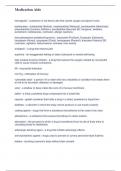
Medication Aide Questions
hemoglobin - substance in red blood cells that carries oxygen and gives it color barbiturates - butabarbital (Butisol), mephobarbital (Mebaral), pentobarbital (Nembutal), phenobarbital (Luminal, Solfoton), secobarbital (Seconal) SE: hangover, sedation, excitement, restlessness, confusion, allergic reactions benzodiazepines (sedation/hypnosis) - estazolam (ProSom), flurazpam (Dalmane), lorazepam (Ativan), quazepam (Doral), temazepam (Restoril), triazolam (Halcion) SE: confusion, agitation, ...
- Exam (elaborations)
- • 11 pages •
hemoglobin - substance in red blood cells that carries oxygen and gives it color barbiturates - butabarbital (Butisol), mephobarbital (Mebaral), pentobarbital (Nembutal), phenobarbital (Luminal, Solfoton), secobarbital (Seconal) SE: hangover, sedation, excitement, restlessness, confusion, allergic reactions benzodiazepines (sedation/hypnosis) - estazolam (ProSom), flurazpam (Dalmane), lorazepam (Ativan), quazepam (Doral), temazepam (Restoril), triazolam (Halcion) SE: confusion, agitation, ...
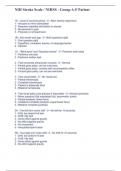
NIH Stroke Scale Group A Patients Guideline
1A - Level of consciousness - 0 - Alert; keenly responsive 1 - Arouses to minor stimulation 2 - Requires repeated stimulation to arouse 2 - Movements to pain 3 - Postures or unresponsive 1B - Ask month and age - 0 - Both questions right 1 - One question right 1 - Dysarthric, intubated, trauma, or language barrier 2 - Aphasic
- Exam (elaborations)
- • 3 pages •
1A - Level of consciousness - 0 - Alert; keenly responsive 1 - Arouses to minor stimulation 2 - Requires repeated stimulation to arouse 2 - Movements to pain 3 - Postures or unresponsive 1B - Ask month and age - 0 - Both questions right 1 - One question right 1 - Dysarthric, intubated, trauma, or language barrier 2 - Aphasic
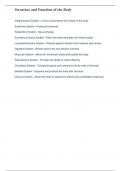
BHB - Body Systems and Functions
Integumentary System - Covers and protects the outside of the body Endocrine System - Produces hormones Respiratory System - Gas exchange Excretory (Urinary) System - Filters the blood and gets rid of liquid waste
- Exam (elaborations)
- • 1 pages •
Integumentary System - Covers and protects the outside of the body Endocrine System - Produces hormones Respiratory System - Gas exchange Excretory (Urinary) System - Filters the blood and gets rid of liquid waste
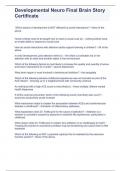
Developmental Neuro Final Brain Story Certificate
Which aspect of development is NOT affected by social interactions? - None of the above Human infants need to be taught how to react to social cues by: - nothing-infants have an innate ability to respond to social cues
- Exam (elaborations)
- • 6 pages •
Which aspect of development is NOT affected by social interactions? - None of the above Human infants need to be taught how to react to social cues by: - nothing-infants have an innate ability to respond to social cues
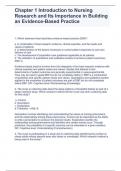
Chapter 1 Introduction to Nursing Research and Its Importance in Building an Evidence-Based Practice
1. Which statement best describes evidence-based practice (EBP)? a. A combination of best research evidence, clinical expertise, and the needs and values of patients b. A determination of the factors necessary to control patient responses to care and delivery of care c. The development of population care guidelines applicable to all patients d. The utilization of quantitative and qualitative studies to enhance patient outcomes - ANS: A
- Exam (elaborations)
- • 14 pages •
1. Which statement best describes evidence-based practice (EBP)? a. A combination of best research evidence, clinical expertise, and the needs and values of patients b. A determination of the factors necessary to control patient responses to care and delivery of care c. The development of population care guidelines applicable to all patients d. The utilization of quantitative and qualitative studies to enhance patient outcomes - ANS: A
